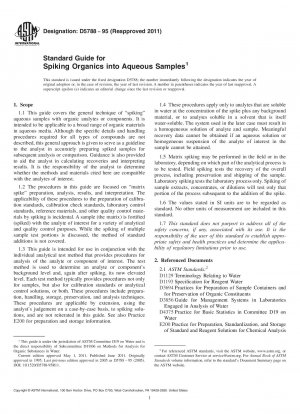ASTM D5788-95(2011)
Standard Guide for Spiking Organics into Aqueous Samples
- Standard No.
- ASTM D5788-95(2011)
- Release Date
- 1995
- Published By
- American Society for Testing and Materials (ASTM)
- Status
- Replace By
- ASTM D5788-95(2017)
- Latest
- ASTM D5788-95(2017)
- Scope
Matrix spiking of samples is commonly used to determine the bias under specific analytical conditions, or the applicability of a test method to a particular sample matrix, by determining the extent to which the added spike is recovered from the sample matrix under these conditions. Reactions or interactions of the analyte or component of interest with the sample matrix may cause a significant positive or negative effect on recovery and may render the chosen analytical, or monitoring, process ineffectual for that sample matrix.
Matrix spiking of samples can also be used to monitor the performance of a laboratory, individual instrument, or analyst as part of a regular quality assurance program. Changes in spike recoveries from the same or similar matrices over time may indicate variations in the quality of analyses and analytical results.
Spiking of samples may be performed in the field or in the laboratory, depending on what part of the analytical process is to be tested. Field spiking tests the recovery of the overall process, including preservation and shipping of the sample and may be considered a measure of the stability of the analytes in the matrix. Laboratory spiking tests the laboratory process only. Spiking of sample extracts, concentrates, or dilutions will be reflective of only that portion of the process subsequent to the addition of the spike.
Special precautions shall be observed when nonlaboratory personnel perform spiking in the field. It is recommended that all spike preparation work be performed in a laboratory by experienced analysts so that the field operation consists solely of adding a prepared spiking solution to the sample matrix. Training of field personnel and validation of their spiking techniques are necessary to ensure that spikes are added accurately and reproducibly. Consistent and acceptable recoveries from duplicate field spikes can be used to document the reproducibility of sampling and the spiking technique. When environmentally labile compounds are used as spikes, the spiking solution shall be protected up to the time of use by appropriate means such as chilling, protection from sunlight and oxygen, or chemical preservation.
Note 18212;Any field spiked sample, if known to the laboratory, should be labeled as a field spike in the final results report. Also, whenever possible, field spiking of volatile compounds should be avoided.
It is often tacitly assumed that the analyte component is recovered from the sample to approximately the same extent that a spike of the same analyte is recovered from a spiked sample. One reason that this assumption may be incorrect is that the spike may not be bound up in the sample (for example, with suspended matter) in the same way that the naturally occurring analyte is bound in the sample. The spike may therefore be recovered from the sample differently than the background level of the analyte. For this reason, as well as the fact that bias corrections can add variability, it is not good practice to correct analytical data using spike recoveries. Spike recovery information should, however, be reported along with the related sample analysis results.
This guide is also applicable to the preparation and use of spikes for quantification by the method of standard additions and to the addition of surrogates and internal standards.
1.1 This guide covers the general technique of “spiking” aqueous samples with organic analytes or components. It is intended to be applicable to a broad range of organic materials in aqueous media. Although the specific details and handling procedures required for all types of compounds are not described, this general approach is given to serve as a guideline to the analyst in accurately preparing spiked samples for subsequent analysi......
ASTM D5788-95(2011) Referenced Document
- ASTM D1129 Standard Terminology Relating to Water*, 1999-04-19 Update
- ASTM D1193 Standard Specification for Reagent Water*, 1999-04-19 Update
- ASTM D3694 Standard Practices for Preparation of Sample Containers and for Preservation of Organic Constituents*, 2017-12-15 Update
- ASTM D3856 Standard Guide for Good Laboratory Practices in Laboratories Engaged in Sampling and Analysis of Water
- ASTM D4375 Standard Practice for Basic Statistics in Committee D-19 on Water*, 1996-04-19 Update
- ASTM E200 Standard Practice for Preparation, Standardization, and Storage of Standard and Reagent Solutions for Chemical Analysis*, 1997-04-19 Update
ASTM D5788-95(2011) history
- 2017 ASTM D5788-95(2017) Standard Guide for Spiking Organics into Aqueous Samples
- 1995 ASTM D5788-95(2011) Standard Guide for Spiking Organics into Aqueous Samples
- 2005 ASTM D5788-95(2005) Standard Guide for Spiking Organics into Aqueous Samples
- 1995 ASTM D5788-95(2001) Standard Guide for Spiking Organics into Aqueous Samples
- 1995 ASTM D5788-95 Standard Guide for Spiking Organics into Aqueous Samples
